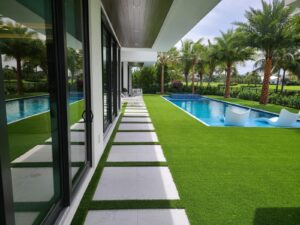Artificial turf, commonly known as synthetic grass, has become a popular alternative to natural grass in various settings due to its low maintenance and durability. But what exactly is artificial turf made of? Understanding the materials and construction of artificial turf can provide insight into its benefits and potential drawbacks. This blog will delve into the components that make up artificial turf and how they contribute to its functionality.
The Components of Artificial Turf
The Base
The foundation of artificial turf is crucial for its stability and longevity. It typically consists of multiple layers, starting with a compacted sub-base made of crushed stone or gravel. This layer ensures proper drainage and provides a solid foundation. Above this is a layer of sand or fine gravel that helps level the surface and provides additional support. Proper base installation is essential to prevent shifting and ensure a smooth, even surface.
The Backing
The backing of artificial turf is made of durable materials such as polyurethane or latex. This layer serves as the structure that holds the synthetic fibers in place. It often features a mesh or grid pattern that provides strength and flexibility. Some backings also include perforations to enhance drainage, allowing water to pass through and preventing the accumulation of puddles on the surface.
The Fibers
Artificial turf fibers or blades are typically made from synthetic materials like polyethylene, polypropylene, or nylon. These materials are chosen for their durability, resilience, and natural appearance. Polyethylene is soft and resembles natural grass, making it a popular choice for residential lawns and playgrounds. Polypropylene is stiffer and more resilient, making it suitable for sports fields. Nylon is the most durable and heat-resistant, often used in high-traffic areas. The fibers are designed to mimic the look and feel of natural grass, providing a realistic and aesthetically pleasing appearance.
Infill Materials
Infill materials are spread between the fibers to provide stability, cushioning, and support. The most common infill materials include sand, rubber granules, or a combination of both. Sand is heavy and helps keep the turf in place, while rubber granules, often made from recycled tires, provide cushioning and shock absorption. Infill materials play a crucial role in the performance and safety of artificial turf, especially in sports and playground applications.
Environmental Considerations
While artificial turf offers advantages such as reduced water usage and lower maintenance, it’s essential to consider the environmental impact of its materials. The production of synthetic fibers involves the use of non-renewable resources and energy. Additionally, disposing of astroturf at the end of its lifespan can be challenging. Some manufacturers are now exploring more sustainable options, such as using recycled materials and developing recyclable turf products.
Conclusion
Artificial turf consists of several key components, including a stable base, durable backing, synthetic fibers, and infill materials. Each of these elements plays a critical role in artificial turf’s overall performance, durability, and appearance. While it offers numerous benefits, it’s also important to be aware of its environmental impact and seek sustainable options where possible. Understanding what artificial turf is made of can help individuals and organizations make informed decisions about its use in various applications.
The Outdoor Living Pros
(689) 600-2827
https://theoutdoorlivingprosorlando.com/

